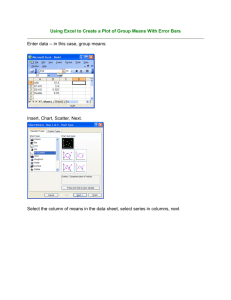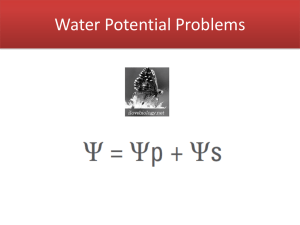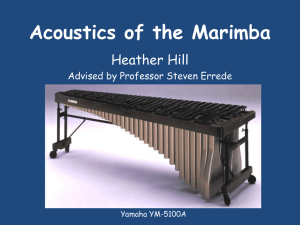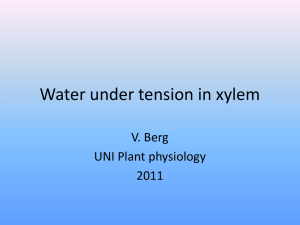Braided Streams - Personal.kent.edu
advertisement
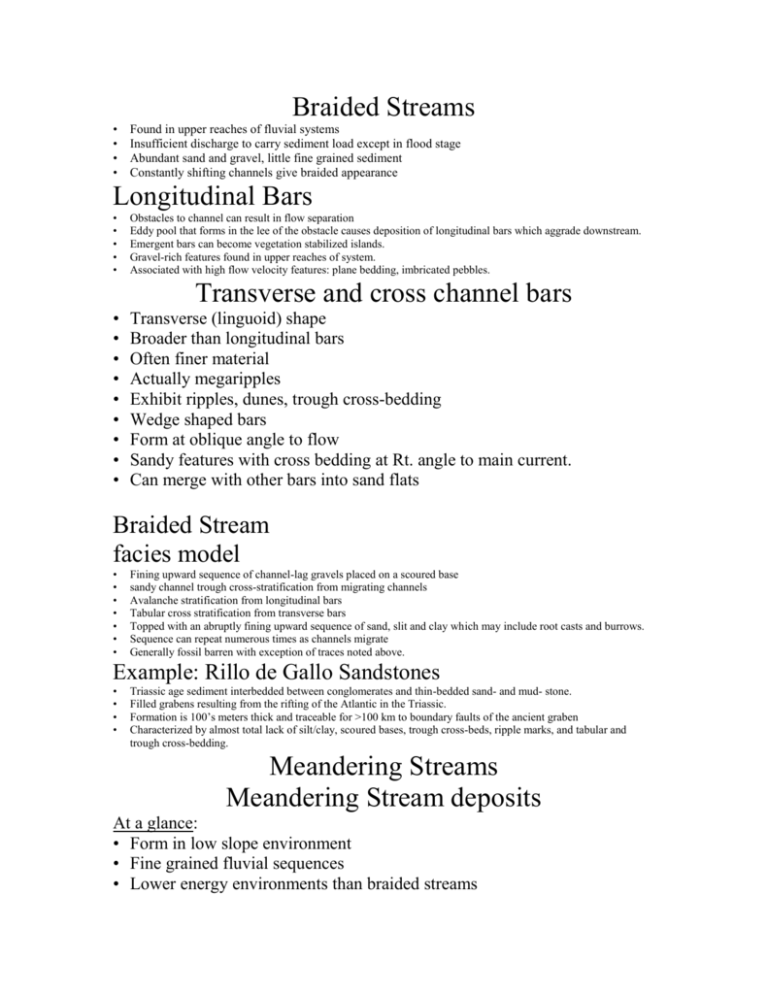
Braided Streams • • • • Found in upper reaches of fluvial systems Insufficient discharge to carry sediment load except in flood stage Abundant sand and gravel, little fine grained sediment Constantly shifting channels give braided appearance Longitudinal Bars • • • • • Obstacles to channel can result in flow separation Eddy pool that forms in the lee of the obstacle causes deposition of longitudinal bars which aggrade downstream. Emergent bars can become vegetation stabilized islands. Gravel-rich features found in upper reaches of system. Associated with high flow velocity features: plane bedding, imbricated pebbles. Transverse and cross channel bars • • • • • • • • • Transverse (linguoid) shape Broader than longitudinal bars Often finer material Actually megaripples Exhibit ripples, dunes, trough cross-bedding Wedge shaped bars Form at oblique angle to flow Sandy features with cross bedding at Rt. angle to main current. Can merge with other bars into sand flats Braided Stream facies model • • • • • • • Fining upward sequence of channel-lag gravels placed on a scoured base sandy channel trough cross-stratification from migrating channels Avalanche stratification from longitudinal bars Tabular cross stratification from transverse bars Topped with an abruptly fining upward sequence of sand, slit and clay which may include root casts and burrows. Sequence can repeat numerous times as channels migrate Generally fossil barren with exception of traces noted above. Example: Rillo de Gallo Sandstones • • • • Triassic age sediment interbedded between conglomerates and thin-bedded sand- and mud- stone. Filled grabens resulting from the rifting of the Atlantic in the Triassic. Formation is 100’s meters thick and traceable for >100 km to boundary faults of the ancient graben Characterized by almost total lack of silt/clay, scoured bases, trough cross-beds, ripple marks, and tabular and trough cross-bedding. Meandering Streams Meandering Stream deposits At a glance: • Form in low slope environment • Fine grained fluvial sequences • Lower energy environments than braided streams Important features: • Flow generally concentrated in a single, meandering channel • Point bars built of scroll bars • Overbank deposits Meanders, Point bars, and Oxbows • • • • • • Streams dissipate current energy by erosive meanders (too close to base level for significant incision). Erosion on outside of meanders Lateral accretion on inside of downstream meanders to form cross bedded point bars. Oxbow lakes form when meanders are cut through during flood stage (avulsion). Oxbows eventually fill with silt/clay to form clay plugs. Form natural levees of over bank silt/clay. Scroll and point bars Point bar sequence (base to top) • Channel lag gravels • High velocity flow, plane laminations • Large scale trough crossbeds of migrating dunes • Low flow velocity sand ripples, climbing ripple lamination • May be capped by overbank silt/clay deposits • Bars may accrete laterally forming scroll bars composed of multiple point bar sequences (Generates epsilon cross-beds) • Timelines are not horizontal, but dipping surfaces parallel to the inside meander bank. Meandering stream facies model • • • • • • • Develop in low slope regions. Grade downstream into deltaic and upstream into braided sequences. Gradual fining upward sequence from basal channel lag gravel to sandy point-bar sequence of trough crossbeds and ripple drift Much finer sediments than braided stream; laminated silts and clays in oxbow lakes, natural levees, crevasse splays and floodplains. Form long ribbon like sands interbedded with clay/shales. High organic content; fossil wood; land vertebrates, invertebrates. Freshwater mollusks are typically present. Example: Powder River Basin of Wyoming • • • • • • Paleocene/Eocene Thick silt/clay deposits with interbedded lenses sandy lenses Economically important source of coal and uranium Tabular sand bodies formed by migrating point bars. Sequence fines upward from coarse to medium grained sandstone to fine grained sand and silt. Five m thick epsilon crossbeds Filled oxbow lakes preserved as organic rich clay- and silt- stones. Lacustrine and Eolian depositional systems Lacustrine Deposits • Excellent recorders of climate • Laminated sequences • Often fossil rich • Lithology can be climate sensitive (e.g. temperate vs. tropical) • Economically important deposits of • Oil shales • authigenic minerals in some cases Lacustrine deposits • Develop in tectonic or other types of depressions. • Lacustrine facies are associated with alluvial fan and fluvial deposits. • Deposits range in size from a few m2 to 100,000’s km2. • Elongate to circular in plan view, lenticular in x-section Lacustrine or Marine? Both can include: • Fine grained rocks; shales and oil shales • Laminations • Deltaic sequences • Turbidites Differences: • Usually smaller scale features in lakes • Less wave influence • Associated with other terrestrial sequences • Distinct fossils Lacustrine facies model • • • • • • • Coarsening upward sequence Finely laminated silt and clay Interbedding with marls, limestones Rippled and X-bedded sandstone and/or conglomerates Mud cracks and rootlets may cap sequence Authigenic minerals may be present for high evaporation rate lakes. Sequence often cyclic • • • Eocene lacustrine formation (~10 Ma sequence) Finely laminated shales interbedded with dolomicrites, volcanic tuffs, authigenic minerals Deep, seasonally stratified anoxic-bottomed lake Unita in south, Ephemeral playa Lake Goshiute in North. Excellent fossil preservation Important source of oil shales, evaporite minerals Example 1: Green River Formation • • Example 2: Newark Basin • • • • Work of Paul Olsen and Dennis Kent Reconstruct terrestrial climate Unravel geologic history of Newark Basin Develop a calibrated magnetic timescale for the late Triassic.

